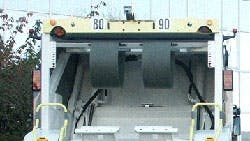Garbage collection gets smart
When a machine's job is to pick up 1,000 bins of garbage a day, it helps to have some intelligence. That's why FAUN Environnement, a vehicle manufacturer in Guilherand Granges, France, is combining brains and brawn in its new Variopress rear loader series. The company is using special sensors from MTS Systems Corp., Sensors Division, Cary, N.C., to monitor the machine's lifting cycle and make the dirty job of refuse collection a little easier, a lot smarter, and safer to boot.
The Variopress can handle containers in different shapes and sizes, ranging from 21 to 290 gallons. This garbage loader uses the Twinlift hydraulic lift and discharge system to ensure speedy truck filling by using a fully automated lifting system. Smaller bins can be lifted by using just one of the lifter units, a configuration that improves productivity by allowing both lifts to operate simultaneously, yet independently. Typically, this added productivity is gained by sacrificing the ability to handle larger bins that require the lifting capacity of a larger single-lift design.
The Twinlift design solves this problem by synchronizing the hydraulics of both lifts through electro-hydraulic motion control. The parallel operation of the lifter units requires synchronization of the hydraulic cylinders while lifting, discharging, and lowering the larger container. For this purpose, MH mobile hydraulic magnetostrictive sensors from MTS are used to monitor the lifting cycle. Each hydraulic cylinder in the lifter units is fitted with an embedded sensor that provides position information back to the controls for the electro-hydraulic valves. The speed of the cylinder — and thus the discharging movement — is controlled based on the position of the lifter unit cylinders.
Knowing the position of the cylinders also allows the electrohydraulic controls to accelerate and decelerate the motion of the cylinders at the end of cylinder stroke. This prevents bottoming out at the end of stroke (and the shocks and load peaks this can cause) so the cylinders are quieter and last longer.
Precise motion control is critical for safe parallel guidance of the lifting units, so the sensor output must be consistent even under the harshest environmental conditions. High sensor accuracy is also a fundamental requirement for uniform discharge control, particularly if the container distributes an uneven load across the synchronized cylinders. The MH sensor, designed specifically to be embedded in hydraulic cylinders, provides high reliability, immunity to interference, and accuracy when compared to other solutions, according to MTS. In addition, magnetostrictive technology does not require direct contact between the position magnet and the sensing element, eliminating any points for wear.
Visit MTS Systems Corp. for more information.